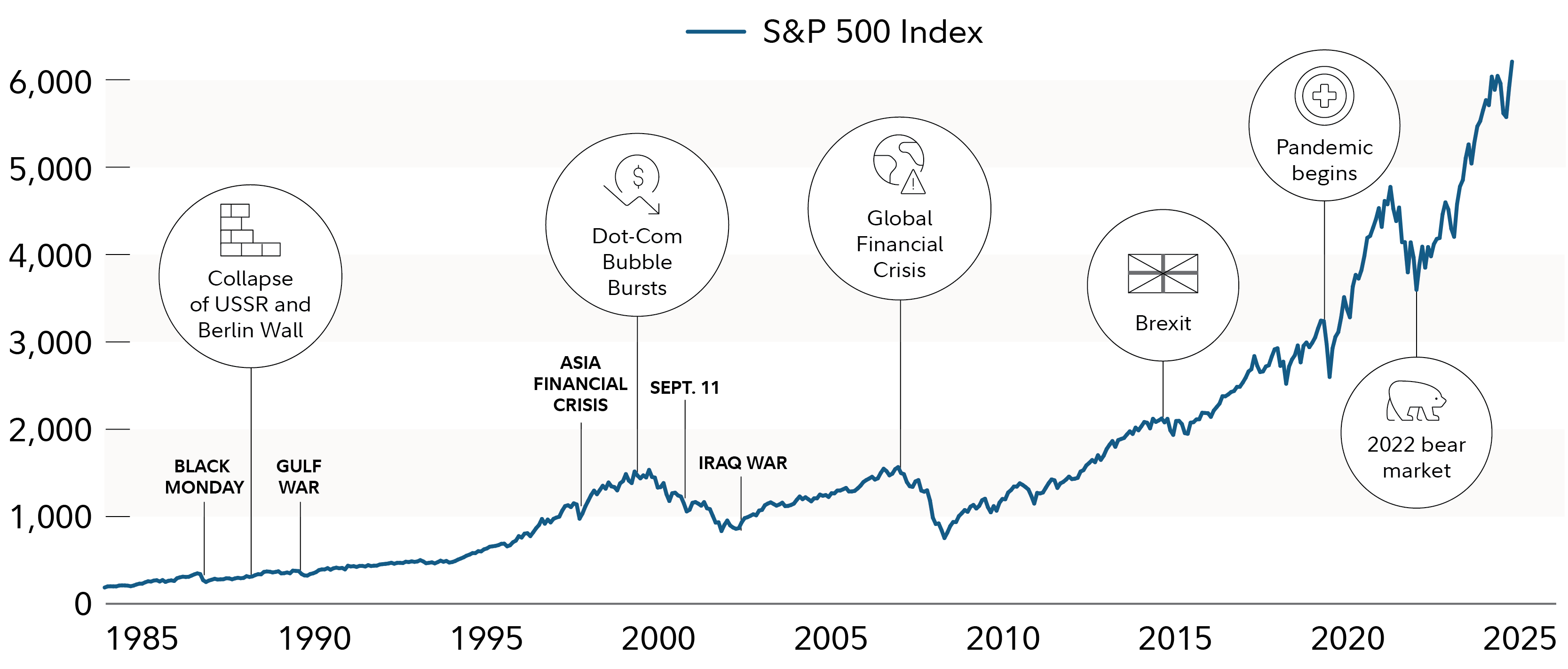Since 1709, the financial world has embraced bears as the mascot for periods when stocks fall on hard times.1 But just because many investors are fearful of bear markets doesn't mean you need to be.
Here's a breakdown of what you should know about bear markets, including tips for your dollars when facing one.
What is a bear market?
A bear market is generally considered a period when stock prices have fallen at least 20% from recent market highs. The closing price of the S&P 500, an index that tracks the prices of 500 large publicly traded US companies, is often used to gauge if the US stock market is in bear-market territory.
Bear markets are the mirror image of bull markets, which are commonly characterized as an increase of at least 20% from market lows. Bear markets are more extreme than market corrections—a term generally used to describe a downward price swing of at least 10% from a recent high.
What causes a bear market?
The price drops that signal a bear market happen when many people sell their investments around the same time. These "sell-offs" happen when investors are concerned about the value of stocks or their future growth. Investors can get anxious about the future of investments for many different reasons—from global conflict and elections to shifting regulations and changes in consumer spending patterns.
How frequent are bear markets, and how long do they last?
During previous bear markets, the median decline in stock prices was 33% off their then-recent highs.2 Over the past 150 years, US stocks have entered bear-market territory about every 6 years, on average.

Historically, the US stock market has recovered from every bear market, often making sizable gains in the months immediately following the downturn.
Do bear markets and recessions go hand in hand?
While many people associate bear markets and recessions, they don't always go together. In about a quarter of bear markets, they haven't.4 In other words, just because the S&P 500 enters into bear-market territory, it doesn't mean you should expect the slowdown in economic activity and jobs that signal a recession.
What should you do during a bear market?
Nobody likes to watch their investment account balance fall. But some investors see falling stock prices as an opportunity. These 4 steps can help you navigate through a bear market.
Check on your emergency savings
Emergency savings are a lifeline even in bull markets. They become more important when things turn bearish. Fidelity's recommendation is to start by saving $1,000, then aim to save 3 to 6 months' worth of essential expenses. This is typically enough to cover you in the event of a major unexpected event, like a job loss or medical emergency. In times of uncertainty, you may consider adding even more buffer, especially if you support more than just yourself or your immediate family.
Not sure how to find extra money for your savings? Read our guide to emergency savings.
Keep your time horizon in mind
Seeing red in your portfolio for an extended time can be stressful. But try not to panic.
Look at your current investment performance in the context of your goals and investing timelines. Chances are that when you started investing, you knew you'd have to weather some down times in order to enjoy the good ones.
Still, bear markets can reveal important realities you may need to face as an investor. If losing money—even temporarily—makes you lose sleep, you may want to revisit your risk tolerance and asset allocation.
Remember: Selling when prices are down means you could miss out on the potential recovery. It's almost impossible to predict when the market will turn around. But historically it always has.
Maintain your investment strategy
When prices are down in a bear market, it can be tempting to put your investment contributions on hold. But just as you generally don't want to make withdrawals from the market when stocks fall, you'll also likely not want to stop making regular contributions to investment accounts.
When you set up automatic contributions through accounts like your 401(k), you're using dollar-cost averaging, a strategy in which you invest the same dollar value, regardless of how the market's doing. You end up buying more shares when prices are low and fewer when prices are high. This positions you to potentially pay less on average per share and see greater gains when the market rises.
If you hit pause on your investments when prices drop, you won't be able to swoop up shares at their discounted rate, which can shrink the impact that dollar-cost averaging has on your portfolio. Also, dollar-cost averaging doesn't assure a profit or protect against loss in declining markets. For the strategy to be effective, you must continue to purchase shares whether the market is up or down.
Consider investing more
If your financial house is in order and you feel prepared for an extended bear market, you can consider looking at a bear market as an opportunity to invest more while prices are low. Another option is rebalancing to bring the overall portfolio back in line with your target allocation and invest more in stocks.
Keep in mind that if you get aggressive with your investments during a bear market, it's impossible to predict when the market will hit bottom. Money you move toward stocks now may be worth less tomorrow. In cases like these, it's especially important to keep an eye on the long term. And, as always, make sure to regularly revisit your financial plan (with a financial professional if you have one) to make sure you're on the right path for your goals.



